Physical Address
304 North Cardinal St.
Dorchester Center, MA 02124
Immunocytology or immunocytochemistry (ICC) involves the application of immunohistochemistry (IHC) in aspiration and exfoliative cytopathology. These immunostains have improved the ability to confidently make specific and accurate diagnoses in cytopathology, and have largely replaced the use of special stains. Not surprisingly, there has been a great deal of progress and expansion in ICC over the past decades given its usefulness, which has led to an increased array of antibodies that are available and, subsequently, an increased use of these antibodies in cytopathology for diagnostic and research applications.
Both aspiration and exfoliative specimens can be used for ICC by utilizing a variety of cell preparations, including cytospins, smears or imprints, liquid-based cytology specimens (e.g., ThinPrep specimens) and cell blocks. The initial cytomorphologic evaluation helps in determining the need for ICC and other ancillary studies in order to reach a definitive diagnosis and exclude other entities in the differential diagnosis. This triage of the specimen includes selection of the optimal cell preparation for immunostains and other ancillary studies, which can help answer important questions and support the diagnosis.
Cytospins, smears, and imprint cytology slides can be air-dried or alcohol-fixed prior to staining. The most important feature is that there is a thin layer of cells without obscuring factors to avoid problems interpreting the stain results. Direct smears are helpful for ICC when there is no other material available; however, the background artifacts and variable thickness can obscure the interpretation of the immunostains, and there is limited material available for a panel of markers. Multiple cytospin slides are also helpful when there is no cell block available. In all of these specimens, prior staining or alcohol fixation may affect the results, and should be considered.
ICC can also be performed using liquid-based cytology or thin-layer techniques, including the proprietary solutions CytoLyt and PreservCyt. These methods have achieved good immunostaining results, with or without processing on the ThinPrep processor. Even with long-term storage in PreservCyt, immunostaining is crisp, the background is cleaner than with direct smears, and immunoreactivity is stable. Some studies have shown that immunostaining for hormone receptors and HER2/neu on alcohol-fixed ThinPrep specimens is not affected by the fixation and correlates well with the results on formalin-fixed paraffin-embedded tissue. However, some antibodies may be affected by the alcohol fixation.
Cell blocks are the most commonly utilized cell preparation that can be used for special stains and ICC ( Fig. 36-1 ). The popularity of cell blocks is largely because processing is similar to paraffin-embedded histology counterparts. Furthermore, cell blocks provide the ability to see tissue architecture, utilize similar controls as histologic stains, and can generate additional replicate sections for a panel of markers by ICC. Interpretation of the results and storage of the specimen are also easier, with unlimited antigen preservation. The main disadvantage of cell blocks is that on-site assessment cannot guarantee a good cell block, the limited availability of material for processing in scant aspirates, and the inability to perform ancillary studies that require fresh, unfixed cells (e.g., flow cytometry).
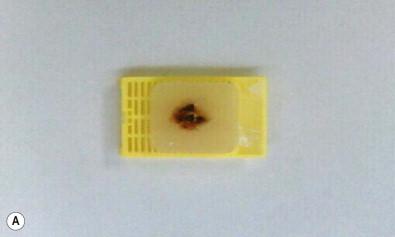
A fully automated rapid cell block system introduced by Cytyc (Cellient; Hologic Inc., Bedford, MA) increases overall cellularity in the resulting sections with decreased time and the necessity for fewer reagents to make a cell block. Cytoscrape cell blocks (SCBs) is another technique to prepare cell blocks, especially from stained fine-needle aspiration (FNA) smears. This technique is useful when cell groups are obscured by clotted blood or when overlapping cell clusters interfere with the cytologic details and make interpretation difficult. The method involves previously stained smears containing thick material that are de-coverslipped in xylene. An advantage of this method is that additional panels of immunostains can be performed on SCB, particularly for cases in which repeat FNA is not feasible.
Although cell blocks are commonly and routinely utilized in non-gynecologic cytopathology, cell blocks can also be helpful in cervicovaginal cytology. The utility of cell blocks prepared from residual material from Papanicolaou (Pap) tests has been reported to be helpful for morphologic evaluation, ICC, and for molecular studies. Cell blocks can be useful for identifying high-grade squamous intraepithelial lesions (HSILs) and glandular abnormalities, in addition to differentiating between atrophy and metaplasia. The diagnostic sensitivity and specificity of cell blocks from the residual samples has been shown to range from 86% to 100%. Another important use of cell blocks is performing ICC when the Pap test interpretation is equivocal. A study that looked at the utility of p16 on cell blocks obtained from the residual samples found that the sensitivity of this immunostain was up to 85% in Pap tests with a diagnosis of ASC-H; another similar study with the use of p16 and MIB1 (Ki-67) found the concordance of Pap test and cell block interpretation to be up to 85%.
Some cytologic preparations are not suitable for ICC. This includes filter preparations because the filter can detach from the slide and absorbs the immunologic reagents and the chromogen leading to high background staining. In addition, fluids with abundant mucoid material, necrosis, blood, or high protein content may have a precipitate that prevents penetration of reagents, and, thus, these specimens may benefit from an additional washing step or use of an alternative preparation for ICC (e.g., a ThinPrep specimen can help to minimize obscuring blood).
The important prerequisites for optimal ICC results include well-prepared material (e.g., thin, uniform spread of cells), with adequate fixation, minimal obscuring factors (e.g., minimal necrosis, blood, mucus, and proteinaceous material), and a reproducible quality-controlled method of ICC. Wet fixation in alcohol (WFA) must be performed without delay because air drying may result in distortion and false-positive results. Air-dried smears (ADSs) are often more cellular than alcohol-fixed slides because some material often floats off the slide when it is alcohol fixed. Such air-dried slides must be fixed immediately before performing ICC, and the types of preferred fixatives vary among cytopathologists and different institutions. Cold acetone, formalin, CytoLyt, and 95% alcohol are commonly used fixatives. One issue with alcohol fixation is that certain antibodies, such as S-100 protein, Hep Par 1, estrogen receptor (ER), and gross cystic disease fluid protein-15 (GCDFP-15), may be leached from alcohol fixatives rendering false-negative results. ER staining on FNA smears using different methods has shown that de-staining the slides with alcohol prior to immunocytostaining significantly reduces the number of cells with positive nuclear staining. The available anti-ER antibodies (ID5, 6F11) perform best with formalin fixation (10%) for hormone receptors, as do other immunostains. Of all the specimens and fixatives, formalin-fixed paraffin-embedded cell blocks provide an optimal specimen for ICC due to better specimen standardization, and, thus, are commonly utilized.
Fixation has been extremely important in the evaluation of breast carcinomas. The 2010 American Society of Clinical Oncology/College of American Pathologists (ASCO/CAP) guideline recommendations for hormone receptor testing highlighted the importance of an accurate and reproducible assay with optimal tissue handling. It is now well recognized that there is a need for standardizing pre-analytic variables, particularly tissue fixation, including the time to fixation (i.e., cold ischemia time), type of fixative, and the duration of tissue fixation. Under-fixation of tissue cannot be repaired and is the least desirable result of handling tissues in the anatomic pathology laboratory. No amount of antigen retrieval can resurrect a tissue that is under-fixed. Antigens will be lost and false negatives will abound in such situations, regardless of the quality of instrumentation. Over-fixation, on the other hand, may result in a specimen needing changes in antigen retrieval, antibody titer, and detection systems. The optimal result is to have a standard fixation time, ideally unique for every antigen. For example, as per the ASCO/CAP guidelines, the recommended minimum fixation in 10% neutral buffered formalin for hormone receptors is no less than 6 hours and no more than 72 hours. Routinely processed cytologic specimens fixed in formalin can also be used to assess the receptor status and HER2 protein by ICC.
The Biologic Stain Commission was one of the original agencies to oversee the special stains used in the anatomic pathology laboratory. The agencies that followed include the Clinical Laboratory Standards Institute (CLSI, previously NCCLS), the Food and Drug Administration (FDA), and commissions set up by professional organizations including the College of American Pathologists (CAP). The emphasis of all these organizations has been on consistent, high-quality assay components for IHC. The consequence of all this work has resulted in the “package inserts” that accompany various IHC reagents. A study by members of the Ad-Hoc Committee on Immunohistochemistry Standardization recommends formalin fixative as the standard for immunohistochemical testing, along with a minimum of 6 hours fixative time for prognostic/predictive markers, including ER, progesterone receptor (PR), and HER2/neu. These guidelines have been incorporated by the ASCO/CAP guidelines for breast cancer hormone receptor testing. Standardization of ICC continues to be an expanding area, as different immunostains and different protocols (e.g., double and multiplex staining) come into use.
Rehydration in normal saline can be done to optimize immunoreactivity as well as cytomorphology for air-dried slides and partially fixed air-dried slides. The optimal time for rehydration is less than 1 minute, provided that the air-drying time does not exceed 30 minutes. This procedure may be used when cytomorphology is critically important, since air-dried slides can sit for up to 1 week at room temperature and still be used for ICC provided they are fixed immediately before use, as already described. Slides for ICC, whether air-dried or fixed, can be stored at −70°C for at least 1 month and still maintain immunoreactivity.
Antigen retrieval is an important step in ICC protocols because pretreatment with retrieval buffers can break the cross-links formed by formalin fixation in the proteins of the tissue, and thereby enhance the number of antigenic sites. These methods typically involve either high-temperature heating of an aqueous solution or the use of enzyme digestion. Although use of metal ions using zinc and lead in the antigen retrieval solutions has shown improved results in many studies, their environmental toxicity has given way to alternatives such as citrate, Tris, urea, and EDTA. Antigen retrieval has been widely used for detection of ER, PR, MIB1, p53, BCL-2, retinoblastoma gene (pRB), and some cluster designation (CD) markers. Though the literature on the subject of use of antigen retrieval on cytology specimens is still evolving, some important studies have successfully shown that antigen retrieval can be applied to these specimens for a wide range of antibodies. Results are satisfactory and are comparable to their tissue specimen counterparts. Sherman and colleagues have shown a method of “cell transfer” that can facilitate immunostaining on small samples. Furthermore, alcohol-fixed smears can be successfully immunostained without antigen retrieval or with mild heat-induced antigen retrieval using citrate buffer. Miller and associates found that FNAs on adhesive slides, followed by antigen retrieval using the same conditions as for routine paraffin sections, substantially improved the ease of interpretation, especially in the air-dried smears.
Appropriate, validated positive and negative controls must be performed with each test sample. Tissue controls are typically used in most laboratories for convenience, but the ideal control should be a comparably fixed cytology sample. It is more practical to use cells on the cytology slide as a positive or negative internal control, depending on the antibody and cells that are present. In a meta-analysis looking at the use of controls in cytopathology articles, only 13% of articles described the use of positive and negative controls run on identically prepared samples. This argues that there should be more stringent documentation of appropriate controls in cytopathology, on par with that seen in surgical pathology.
There are several important uses of ICC in cytopathology, which are summarized in Box 36-1 . These include determination of cell type (e.g., lymphoid versus epithelial cells using CD45/leukocyte common antigen (LCA) and cytokeratin, respectively) ( Fig. 36-2 ), determination of tissue of origin in a tumor of unknown primary, grading of particular malignancies (e.g., Ki-67 in neuroendocrine, hematolymphoid, and mesenchymal tumors), determination of prognostic and predictive markers for treatment, and subtyping of infectious etiologies. One of the advantages of ICC is that the morphology of the cells is still evident with these stains, unlike flow cytometry or molecular studies. Correlation with the morphology allows one to see the type of cells that are staining (e.g., tumor cells vs. background contaminating benign cells) and the compartment of the cell that is staining (e.g., nuclear vs. cytoplasmic). In addition, when the morphology is ambiguous or distorted, ICC can characterize these cells beyond what is possible by cytomorphology ( Fig. 36-2 ).
Defining cell type of origin
Determining tissue of origin with site-specific markers
Determining the type of infection
Subclassification or subtyping of tumors
Grading of malignancy
Providing prognostic and predictive information
Other: research applications
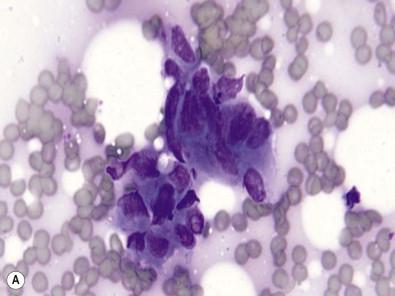
The use and interpretation of ICC presents some challenges for the laboratory and pathologist, in that accurate and reliable staining depends on numerous factors, as described previously, including the presence of neoplastic cells, the location of staining, proper handling and fixation, quality control, and antibody concentration. In addition, ICC results must be correlated with the morphology, clinical, and radiologic findings for accurate interpretation and to avoid a false-positive or false-negative diagnosis, and cannot be used in isolation. Numerous antibodies are available for use in cytology, and none of them is specific for its intended target. Antibodies used in ICC can be polyclonal or monoclonal, may be derived from a variety of animals (e.g., mouse or rabbit), vary in sensitivity and specificity, and may require certain processing or handling. In addition, the differentiation of many tumors exhibits a wide spectrum. For these reasons, it is important to use and to document the known positive and negative controls for different antibodies. Furthermore, a panel of antibodies are typically selected to include markers that are known to be positive and negative in the entity, in order to maximize sensitivity and specificity. Immunostaining for any antigen is rarely uniform in nature; thus, it is important to state the pattern, cell localization, and distribution of immunostaining relative to normal cells.
False-positive immunostaining results can be a result of a multitude of factors, including interpretation errors and technical errors. First and foremost, the cytopathologist must not mistake normal or reactive cellular elements for neoplastic cells, especially in samples in which neoplastic cells are limited. Poorly preserved or problematic specimens (e.g., necrotic, air-dried, or thick specimens) can also result in nonspecific antibody binding during any step in the immunoperoxidase procedure and yield a false-positive result. Polyclonal antibodies can also show nonspecific binding to stromal elements, which can be avoided by carefully assessing the pattern of staining of normal, neoplastic, and stromal elements. Antibodies may cross-react with non-lesional components, or the antibody used may not be as specific as advertised. Only experience and comfort with the antibody in use will satisfy the observer's interpretation in these situations. Improper fixation and incomplete blocking of endogenous peroxidase or biotin activity are well-known sources of false-positive results. Proper blocking with commercial blocking products should eliminate this problem. Furthermore, one must avoid interpreting immunostains on the edge of the tissue section, in the setting of uneven staining with high background, and with folded or obscured tissue, which could lead to false-positive results ( Fig. 36-3 ). Finally, appropriate chromagens should be selected in pigmented lesions, such as malignant melanoma, since the brown chromagen can be confused with brown melanin pigment in the tumor, and a negative immunostain could be falsely interpreted as positive result ( Fig. 36-4 ).
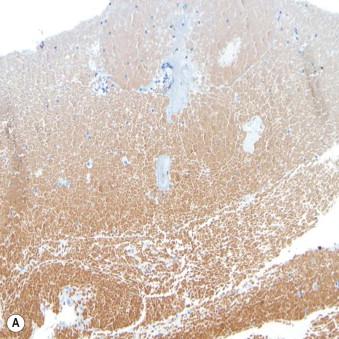
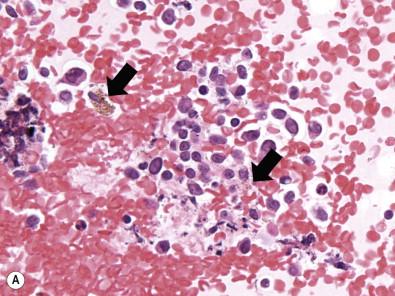
False-negative interpretations can also be problematic and arise from a variety of potential issues. Denaturation or masking of the antigen due to improper fixation may completely escape the observer. One can eliminate this problem only by ascertaining the working dilution of each antibody and ensuring quality control. Antibody concentration is a critical determinant, as concentrations that are too low or too high can cause false-negative and false-positive results, respectively. Insufficient antigen retrieval or even de-colorization of specimens can cause false-negative results. The type of fixation is critical for antibody performance. The best example of false-negative results occurs for certain antibodies when a sample is fixed in alcohol, and this has been reported with antibodies to S-100 protein, GCDFP-15, and others. A summary of the common causes of false-positive and false-negative findings in immunocytology are given in Table 36-1 .
| Causes of False-positive Results | Causes of False-negative Results |
|---|---|
| Antibody issues (e.g., poor specificity of antibody, cross-reactivity of antibody, nonspecific binding, high concentration of antibody) | Insufficient antigen retrieval |
| Decolorization of the cells | |
| Misinterpretation of cellular component of interest or pattern of staining | Lack of cell population of interest (e.g., sample with only benign cells without neoplastic cells of interest) |
| Insufficient peroxidase-biotin blocking | Antigen expression too low or blocked |
| Specimen quality issue (e.g., necrotic specimen, thick smears or other specimen type, air-drying artifact) | Antigen diffusion or loss (e.g., S100 in alcohol-fixed specimens) |
| Improper fixation | Poor antigen preservation or fixation (e.g., prolonged fixation or denaturation) |
Additional issues in interpretation of ICC occurs with obscuring inflammation, necrosis, excess bacteria, crystalluria, hematuria, poor preservation of cells, and poor cellularity (<50 cells), which may cause the test to fail or become uninterpretable. In addition, there can be failure of the controls, high background staining, uneven staining, or obscuring folded tissue or floaters, and other technical variables that make the interpretation difficult ( Fig. 36-3 ). In these scenarios, analysis of the problem and repeating the stains can be helpful.
ICC can be hampered by a limited quantity of the specimen, which happens more often in cytopathology than in surgical pathology. Thus, these cases require special handling, including maximizing the material acquired at the time of the procedure, maximizing the amount done with the tissue, and minimizing cell loss in processing. At the time of the procedure, education of the performer of the biopsy is important to stress the importance of satisfactory material for theranostic testing or diagnosis. Furthermore, acquisition of additional passes for cell block or obtaining a small core biopsy can be helpful to acquire material for ancillary studies. These limited specimens can also be triaged in a special manner in order to help preserve material, by cutting extra blank slides upfront and using limited immunopanels. In some laboratories, alternate material may be selected for ICC including smears, liquid-based preparations, and cytospins. New developments that can also maximize findings from small specimens include immunolabeling of two antibodies on the same slide instead of separate slides, or using even more antibodies multiplexed on the same slide, and this has been shown to provide satisfactory results. Typically, dual staining involves the use of more than one antibody, typically a nuclear and cytoplasmic or membranous stain, on the same slide, opposed to separate slides ( Fig. 36-5 ). Furthermore, cytology slides that were subjected to an immunoperoxidase test and produced a negative result or a negative control slide can also be subjected to another immunoperoxidase test using a different antibody. For example, a poorly differentiated tumor that is found to be negative for LCA, can then be tested with cytokeratin to determine if it is an epithelial tumor. Some of the ways to maximize the cytologic material available for ICC are summarized in Box 36-2 .
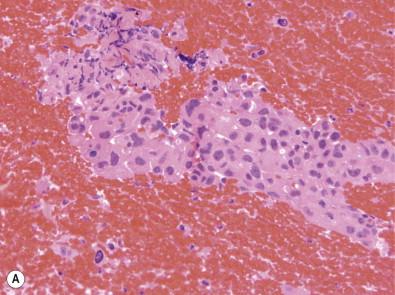
Education about importance of procuring sufficient tissue
Selection of optimal type of specimen (e.g., exfoliative or aspiration cytology)
Rapid on-site assessment by cytologists for adequacy assessment and triage
Selection of appropriate fixative and processing
Additional dedicated material for ancillary studies
Established, validated, and standardized laboratory protocol for processing and evaluation
Conservation of tissue and triage of the blank slides for the appropriate stains
Limited immunoperoxidase staining panels
Using alternative material in cases with insufficient tissue in the cell block (e.g., aspirate smear material).
Use of alternative procedures in cases of scant material (e.g., dual immunostaining or multiplex immunostaining).
Optimization and assessment of specimen processing (e.g., quality assurance).
Effusion cytology is one of the most challenging areas of cytopathology, wherein ICC serves as a valuable adjunct tool in definitive interpretation. A panel of immunostains is critical to distinguish a metastatic adenocarcinoma from background reactive mesothelial cells, since mesothelial cells can show significant atypia mimicking adenocarcinomas and other malignancies. In the absence of these studies, the sensitivity for the detection of malignant cells has been reported to be as low as 40%. Thus, using a panel of antibodies comprising both mesothelial and adenocarcinoma markers can significantly improve diagnostic accuracy ( Table 36-2 , Figs 36-6 , 36-7 ). Storage of effusions at 4°C gives a satisfactory immunohistochemical outcome when a delay in processing of the samples is anticipated, and optimal results are achieved when ICC is performed on 10% phosphate-buffered formalin cell blocks.
| Mesothelial Markers | Adenocarcinoma Markers |
|---|---|
| Calretinin | MOC-31 |
| WT-1 | BerEP4 |
| D2-40 | B72.3/TAG |
| HBME-1 | mCEA |
| CK5/6 | LeuM1/CD15 |
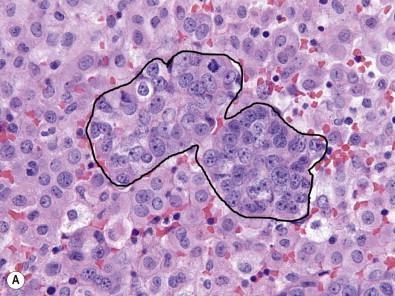
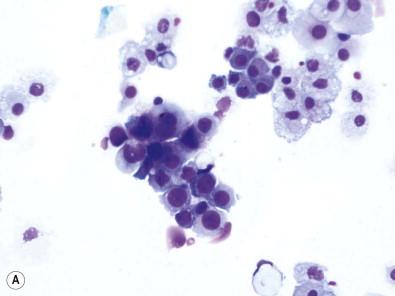
Calretinin in the most common immunostain used for highlighting mesothelial cells. The 29 kDa calcium-binding protein is a member of elongation factor (EF) proteins, and is thought to play a role in the cell cycle. However, it cannot distinguish benign or reactive mesothelial cells from malignant mesothelial cells (i.e., mesothelioma) ( Fig. 36-6C,D ). The expression of calretinin by epithelioid mesotheliomas and epithelioid components of mixed mesotheliomas was first described in 1996. These results were later confirmed by other studies showing only rare focal positivity, primarily as a cytoplasmic blush, in a variety of carcinomas, including 10–30% of adenocarcinomas. The sensitivity of calretinin to distinguish reactive mesothelial cells from adenocarcinoma cells approaches 100%, and the specificity is up to 80%. Interpretation of this marker is based on finding strong nuclear and cytoplasmic positivity in the cells of interest ( Fig. 36-6D ).
Cytokeratin 5 was found to be present in mesothelioma and absent in adenocarcinoma in a few early studies, which was confirmed later in larger series reporting only focal staining in less than 10% of adenocarcinomas. The diffuse cytoplasmic staining of CK5/6 has not only been seen in mesothelial cells, including mesotheliomas, but is also positive in squamous cell carcinomas. The sensitivity and specificity of this stain in distinguishing malignant mesothelioma from adenocarcinoma in pleural effusions is 90–100%. However, this marker is of no value in differentiating mesothelial cells from metastatic squamous cell carcinoma. A subset of other basal-like tumors can also express CK5/6, including breast carcinomas with a basal-like phenotype. Given these data, CK5/6 is primarily used as a second-line marker for differentiating mesothelioma and reactive mesothelial cells from adenocarcinoma.
Wilms' tumor gene (WT-1) is a tumor suppressor gene present on chromosome 11 that shows nuclear positivity in mesothelial cells ( Fig. 36-6C ). The immunohistochemical expression of WT-1 can be seen in a variety of neoplasms, such as serous tumors of the ovary, leukemia, desmoplastic small round cell tumors, and others. In addition, a majority of epithelioid mesotheliomas and a small percentage of sarcomatoid mesotheliomas express WT-1. WT-1 represents an effective nuclear marker for mesotheliomas as well as reactive mesothelial cells. However, in recent years, WT-1 has emerged as a highly sensitive and specific marker for carcinomas of Müllerian origin. Therefore, one should avoid including WT-1 in an immunopanel when suspecting a metastatic carcinoma of ovarian serous type because strong nuclear positivity can be seen in serous tumors and mesothelial cells.
D2-40 was initially used in surgical pathology as a marker for lymphatic endothelium to demonstrate lymphovascular space invasion, but was also found to be expressed by benign and neoplastic mesothelial cells. D2-40 is a highly sensitive and specific marker for malignant mesothelioma, and, therefore, can be used in a panel to distinguish mesothelioma or mesothelial cells from pulmonary carcinomas in pleural effusion cytology specimens. However, D2-40 expression has also been reported in approximately 50% of ovarian carcinomas, 30% of lung carcinomas, and 30% of breast carcinomas. Thus, in situations where an ovarian tumor is a consideration, one should avoid D2-40 and WT-1 as immunomarkers in the panel given that they may not distinguish mesothelial cells from a metastatic ovarian carcinomas.
GLUT1 is an immunostain that, unlike the prior immunostains mentioned, can help to identify a malignant mesothelioma from simply reactive mesothelial cells, which is a difficult or impossible distinction based on morphology alone. It is a member of the family of glucose transporter isoforms (GLUT) that facilitates the entry of glucose into cells and is expressed in a variety of malignancies. GLUT1 expression is confirmed by membranous staining and red blood cells are a helpful internal positive control. GLUT-1 has been reported to be a sensitive and specific immunohistochemical marker for differentiating reactive mesothelial cells from malignant mesothelioma. It cannot, however, discriminate between malignant mesothelioma and other malignancies. Thus, ICC with other mesothelial and adenocarcinoma markers is required to confirm that the malignant population is mesothelial in origin, in addition to using GLUT1 as a proposed “malignancy marker.” In a comparison of GLUT1 with fluorescence in situ hybridization (FISH) detection of the p16 gene deletion in mesothelioma, the p16 gene deletion was found to be more sensitive and specific as a malignancy marker than immunostaining with GLUT1; however, some laboratories prefer to use immunostains which are technically easier to perform than FISH studies that may not be available.
Become a Clinical Tree membership for Full access and enjoy Unlimited articles
If you are a member. Log in here